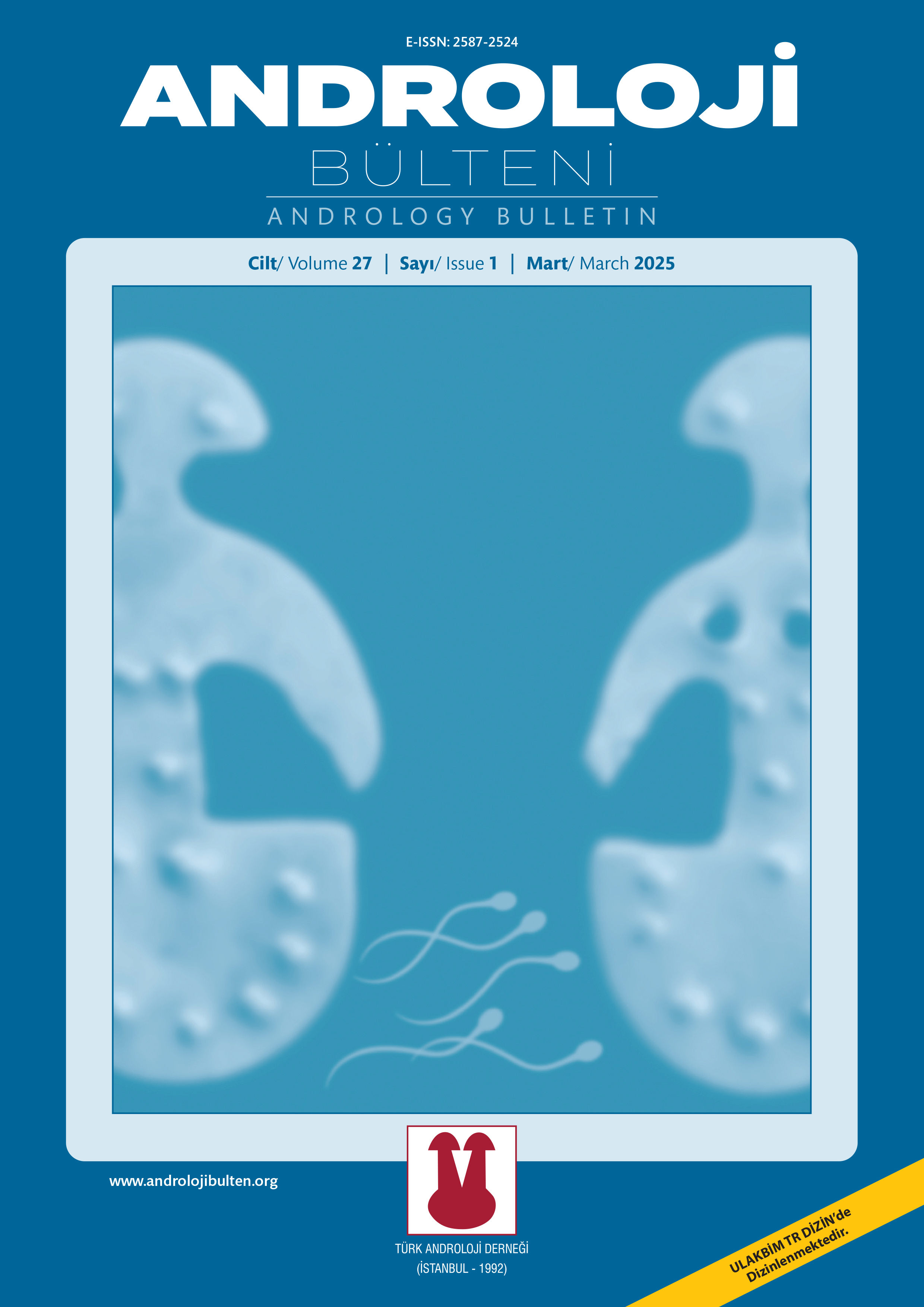
Content of this journal is licensed under a Creative Commons Attribution-NonCommercial 4.0 International License.
Is testicular tunica vaginalis autologous graft successful in the surgical treatment of peyronie’s disease?
Kenan Yalçın, Engin Kölükçü, Fatih Fırat, Fikret ErdemirDepartment of Urology, Tokat Gaziosmanpaşa University Faculty of Medicine, Tokat, TürkiyeOBJECTIVE: Peyronie’s disease (PD) is an acquired benign connective tissue disorder characterized by fibrosis and plaque formation within the tunica albuginea of the penis. Treatment approaches for PD include oral agents, mechanical therapies, intralesional injections, and surgical interventions. In this study, we aimed to evaluate the outcomes of using testicular tunica vaginalis autologous grafts in the surgical treatment of Peyronie’s disease.
MATRERIAL and METHODS: Nineteen patients who underwent surgery with the use of testicular tunica vaginalis autologous grafts between 2015 and 2022 were evaluated. All patients reported a decreased frequency of sexual intercourse and difficulties with sexual intercourse. Each patient exhibited significant curvature during erection. During the operation, the fibrotic plaque was excised while preserving the neurovascular bundle (NVB). A suitable autologous tunica vaginalis graft was harvested to match the size of the excised plaque and was used to repair the defect. Patients with curvatures exceeding 90°, those who had previously undergone penile surgery, and those with abnormal penile Doppler findings were excluded from the study. Preoperative and postoperative parameters were collected and compared. The patients were assessed using the International Index of Erectile Function (IIEF-5) before surgery and one year postoperatively. Residual curvature was also evaluated in all patients at the one-year follow-up.
RESULTS: The mean age of the 19 patients who underwent surgery with testicular tunica vaginalis autologous grafts was 51.95 years (44-61), and the mean operative time was 70.26 minutes (56-80). The mean size of the excised plaque was 2.82 cm² (2-4). The overall satisfaction measured by the IIEF-5 score one year postoperatively showed a statistically significant improvement compared to preoperative scores (p<0.05). All surgeries were completed successfully without complications, and satisfactory correction of penile appearance was achieved in all patients. No significant difference was observed in the length of the erect penis before and after surgery. In two cases, a 20° residual curvature was observed, and in two other cases, a 15° curvature was noted at the one-year follow-up. No residual curvature was observed in the other patients.
CONCLUSION: Covering the defect following Peyronie's plaque excision with the patient’s own tunica vaginalis is a simple, cost-effective, and safe method that produces satisfactory outcomes. These findings should be confirmed in larger series.
Peyronie hastalığının cerrahi tedavisinde testiküler tunika vajinalis otolog grefti başarılı mı?
Kenan Yalçın, Engin Kölükçü, Fatih Fırat, Fikret ErdemirTokat Gaziosmanpaşa Üniversitesi Tıp Fakültesi Üroloji Anabilim Dalı, Tokat, TürkiyeAMAÇ: Peyronie hastalığı (PH), tunika albuginea içinde fibrozis ve plak ile karakterize, penisin edinilmiş iyi huylu bir bağ dokusu bozukluğudur. PH’nin tedavisi oral ajanlar, mekanik tedaviler, intralezyonel ve cerrahi tedaviler gibi yaklaşımları içerir. Peyronie hastalığının cerrahi tedavisinde testiküler tunika vajinalis otolog greftinin sonuçlarını değerlendiren bir çalışmayı amaçladık.
GEREÇ ve YÖNTEMLER: 2015 ile 2022 yılları arasında peyronie hastalığı cerrahisinde testiküler tunika vajinalis otolog grefti kullanılan 19 hasta değerlendirildi. Hastaların tamamı cinsel ilişki sayısının azalmasından ve ilişkide zorlanmadan şikayet etmekteydi. Tüm hastalarda ereksiyon sırasında belirgin kurvatür vardı. Operasyon sırasında fibrotik plak eksize edildi ve nörovasküler demet (NVB) korundu. Eksize edilen plağın boyutuna uygun otolog tunika vajinalis greft olarak çıkartılıp defekt kapatıldı. 90° üzerinde kurvatürü olan, daha önce penisten cerrahi geçiren, penil doppler tetkiki anormal olan hastalar çalışma dışı bırakıldı. Operasyon öncesi ve sonrası parametreler toplanıp karşılaştırıldı. Hastalar operasyon öncesi ve operasyondan 1 yıl sonra Ereksiyon İşlevi Uluslararası Değerlendirme Formu (IIEF-5) ile değerlendirildi. 1.yılda rezidü kurvatür açısından tüm hastalar değerlendirildi.
BULGULAR: 19 testiküler tunika vajinalis otolog grefti kullanılan hastaların ortalama yaşı 51.95 yıl (44-61), ortalama operasyon süresi 70.26 dk (56-80) idi. Eksize edilen plağın ortalama boyutu 2.82 cm2 (2-4) idi. Ameliyat öncesi ve ameliyat sonrası 1.yıl IIEF-5 ile ölçülen genel memnuniyet istatistiksel olarak anlamlıydı (p<0,05). Operasyonların tamamı komplikasyon yaşanmadan başarıyla tamamlandı. Tüm hastalarda penis görünümünde tatmin edici bir düzelme sağlandı. Erektil penis uzunluğu operasyon öncesi ve sonrası arasında anlamlı bir fark görülmedi. Ameliyat sonrası 1.yıl takiplerde testiküler tunika vajinalis otolog grefti kullanılan 2 olguda 20° kurvatür ve 2 olguda 15° kurvatür gözlendi. Diğer hastalarda rezidüel kurvatür izlenmedi.
SONUÇ: Peyronie plak eksizyonunu takiben defektin hastanın kendi tunika vaginalisi ile kapatılması basit, masrafsız ve tatminkar sonuçlar aldığımız güvenli bir yöntemdir. Elde edilen bu sonuçların daha büyük serilerde onaylanması gerekmektedir.
Manuscript Language: English
(186 downloaded)













